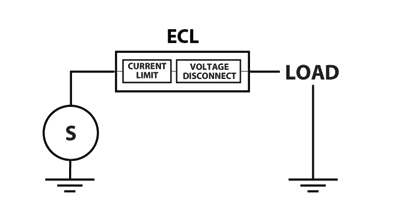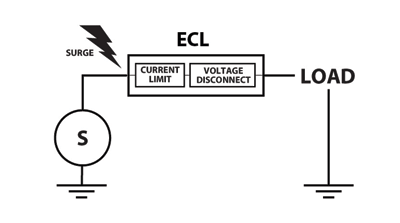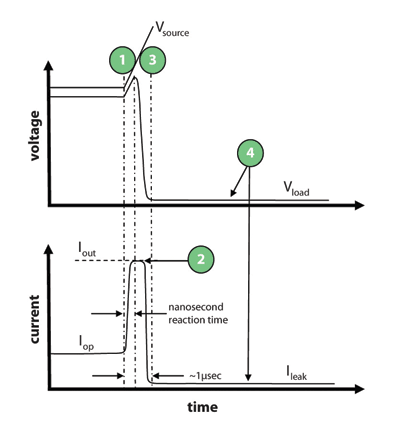Electronic current limiters offer superior protection
High-speed ECL devices provide simple yet effective protection for electronic equipment
BY IAN DOYLE
Product Line Manager of Semiconductor Products, Bourns
www.bourns.com
A new method of circuit protection allows designers greater flexibility and increased reliability while reducing the time to market. The long-accepted assumption that hundreds of amperes and thousands of volts cannot be blocked with a cost-effective circuit protection solution is now changed with the availability of electronic current limiter (ECL) devices.
This circuit protection technology introduces a solution that effectively protects sensitive electronic equipment within nanoseconds of a power threat, and provides the added benefit of being resettable. ECLs are designed to work with existing circuit protection solutions to virtually eliminate latency. The result is superior surge protection for a variety of applications.
Offering an optimal circuit protection solution, ECLs block a surge rather than shunting it for both power cross and lightning threats. ECLs also provide extremely effective, wide bandwidth circuit protection against lightning, power induction, power cross and short circuit events at a reasonable cost. This article will discuss conventional devices that often fall short of full circuit protection. It will also examine ECL devices and present how designers can use them as an ideal circuit protection solution for sensitive electronic equipment.
Conventional surge protection
Surge protection is the process of protecting electronic systems or equipment from currents and voltages that are outside their safe operating limits. These surge currents and voltages can be generated by short circuits, lightning or faults from a power system and typically enter the electronic system along inter-equipment wiring. Two primary methods exist for implementing protection against surge threats, namely diverting (shunting) or blocking the surge.
Conventional protection methods used today are mostly based on shunting architectures to divert the current. This is due to the widespread perception that only higher-priced devices are readily available to shunt faults of hundreds of amperes and thousands of volts.
It is important to note, however, that none of the available shunt devices is sufficient to protect electronic equipment by itself. For example, non-semiconductor surge protectors, such as the gas discharge tube (GDT) are slower to react, allowing high and often dangerous voltages to occur prior to the activation of the GDT.
As a result, GDTs typically do not keep voltages low enough to provide adequate protection by themselves. And, the alternative semiconductor-based overvoltage protection devices tend to have limited current handling capability.
Hence, protection systems are usually based on a number of coordinated stages of overvoltage and overcurrent protection devices. Either a thermally activated series fuse or a positive temperature coefficient (PTC) acting as a current-limiting blocking device is used to prevent the transient voltage developed across the overvoltage protector from exceeding the ratings of the protected equipment.
Thermally activated devices are “let-through” energy dependent, which means that their activation depends upon a product of the square of the RMS current, the resistance of the protector, and the time duration of the current. Testing is required to assess the performance of a design and to ensure adequate protection within a specific system.
This requirement has created the vast array of testing and design standards. However, due to the significant amount of let-through energy required to activate the overcurrent protectors in use today, virtually all existing designs have inherent weaknesses such as sneak currents, fast-rising voltages, high energy surges, or surges of a particular frequency or a particular rate of repetition. These weaknesses can cause field failures, resulting in lower system reliability and the possibility of incurring costs for maintenance and replacement devices.
Ideal circuit protection
Blocking a transient through an electronic current disconnecting mechanism rather than an energy dependent thermally activated device is the ideal form of circuit protection. ECL devices (see Fig. 1 ) allow for superior surge protection because their high-speed protector blocking technology virtually eliminates latency in the circuit protection design, which always limits the current to less than a specified amount for complete protection.

Fig. 1: ECL devices provide superior circuit protection.
Next-generation high-speed ECL devices match the following list of system requirements for circuit protection:
A predictable, stable and low trigger current (a current that causes a device to switch between its conductive and non-conductive state) that provides effective protection for sensitive downstream equipment.The ability to block the let-through energy of the primary protector as a series component (in series with the transmission line), located just after the primary protector. Operating as a series component, the device will quickly react to current through the device at a defined level rather than voltage across the interface.Very fast-acting (ECL device in action
A lightning or power cross event (see Fig. 2 ) at time 1 (see Fig. 3 ), raises the voltage and current until the current limiting portion of the circuit limits current to the level of Iout time 2 (~10 ns). At this point, the voltage disconnect portion of the circuit operates and by time 3 (~1 µs), the load is disconnected from the surge. During the remainder of the surge (time 4), the ECL device remains in the protected state of very low current and voltage at the load.

Fig. 2: Overvoltage fault diagram.

Fig. 3: ECL device reaction to an overvoltage fault.
High-speed ECL protector benefits
High-speed ECL protector devices deliver near ideal current blocking protection for both power cross and lightning. Benefits include overvoltage and overcurrent protection in one device, precise output current and voltage limiting, high blocking voltages and currents, extremely high-speed performance, very high bandwidth, repeatable and stable resistance and a small size. These advantages give designers a protection device that provides automatic protection coordination, is gigahertz (GHz) data rate compatible within a small printed circuit board area and exceeds Telcordia GR-1089 and ITU K.20/K.21 requirements. These next-generation devices provide designers with a simple yet superior protection device for sensitive electronic equipment. For information about ECL models from Bourns, visit http://www.bourns.com/ProductLine.aspx?name=tbu. ■
Advertisement
Learn more about Bourns





